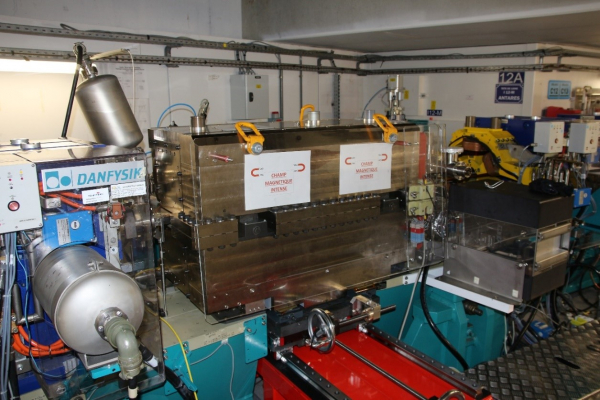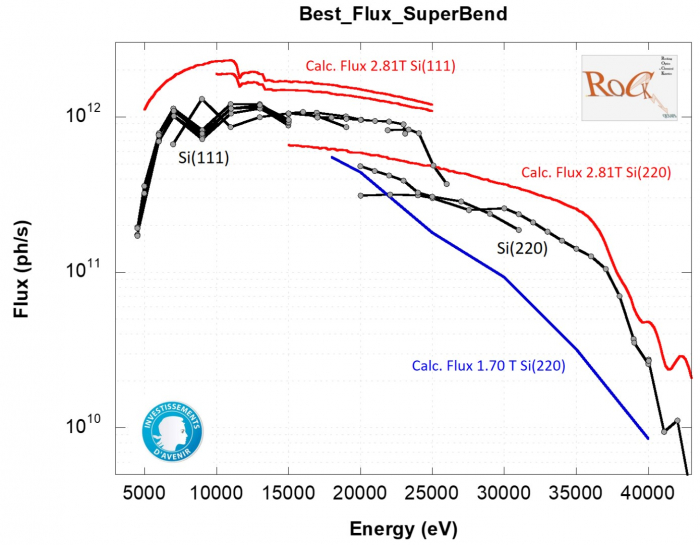On August 25, 2021, the synchrotron was restarted after the summer shutdown with a storage ring containing a new magnetic element made entirely of permanent magnets, the Superbend. Producing a magnetic field of 2.8 T, it replaces one of the 32 electromagnetic dipoles (magnetic field of 1.7 T) of the ring to allow the ROCK beamline to exploit more intense photon fluxes in the hard X-ray range, thus opening up new perspectives in X-ray absorption spectroscopy.
The realization of this dipole in permanent magnets is a technological feat because the magnetic forces involved are gigantic. The first measurements carried out on the ROCK beamlline have highlighted the expected increase in photon flux.
The Superbend was designed to be installed in place of the existing ROCK photon source, without moving the beamline optics and instruments and without affecting the nominal operation of the storage ring. A first technological breakthrough was achieved with the choice of a permanent magnet dipole to replace the standard electromagnetic dipole, with a magnetic field of 2.8 T produced only at the ROCK source point to minimize the power to be dissipated on the existing absorbers. The Superbend is therefore composed of a "high field" entrance part (for the 1° exit port of ROCK) and a "low field" part which completes the total deviation of electrons of 11.25°. To reach the field of 2.8 T, the magnetic gap is reduced from 37 mm (standard dipole) to 16.1 mm requiring the construction of a new vacuum chamber, with a total internal vertical aperture reduced to 12 mm instead of 25 mm for the standard vacuum chamber. Given the risks on the performance of the machine with such a "bottleneck" for electrons at the ROCK source point, preliminary modeling was necessary to validate the choices and give a green light in 2018 to the realization of the Superbend, whose funding was provided in part by the ANR in the framework of the Equipex ANR-10-EQPX-45 project.

Figure 1: Comparison of the performances of the standard dipole and the Superbend. Left: variation of the magnetic field along the electron trajectory. Right: variation of the photon flux as a function of the photon energy (calculated at 8.7 m from the source point for an aperture of 13 x 2.4 mm²).
The assembly of a large quantity of permanent magnets (350 kg), around the poles of the steel yoke has also led to many technical challenges related to strong magnetic forces, requiring the design of specific tooling to allow a secure assembly protocol. Magnetic measurements then allowed to adjust the field integral on the theoretical value and to calibrate the magnetic field variations as a function of temperature, a well-known phenomenon for permanent magnets. To compensate for these variations, an electromagnetic correction coil was installed on the "low field" part with a power supply connected to the control system of the ring to be remotely controlled if necessary. During the August 2021 technical shutdown, the Superbend, a 1.3 m long, 3.5 ton "little baby", was installed in place of the standard dipoleleaving a gap of only 0.2 mm between the vacuum chamber and the poles !

Figure 2: The Superbend installed in its place in the storage ring tunnel. In red, the equipment dedicated to extract the dipole if a vacuum chamber bakeout must be performed, the magnetic properties of the permanent magnets being deteriorated for temperatures higher than 120°C.
On August 25, 2021, the first electron beam was stored in the presence of the Superbend and no field integral correction was required. This was followed by a series of experiments to characterize and optimize the performance of the storage ring. The magnetic field mapping had allowed to model the important effect of the Superbend on the beam dynamics and to compensate for its focusing effect. Despite the expected decreases in injection efficiency and lifetime, the beam characteristics are not changed. On August 27, 2021, the first photon beam was observed on ROCK and the 25 keV photon energy was first characterized, immediately confirming the flux increase by a factor of 3 at this energy. On August 29, 2021, characterization at the 40 keV photon energy was performed, confirming the expected flux increase with an effective gain at this energy of a factor of 7.4!
The Superbend is in operation at SOLEIL since Tuesday, September 7, 2021 with satisfactory performances for the machine. It is "transparent" for the operation of the other beamlines.
On the ROCK beamline, the increase of the photon flux causes deformations of the optical equipment, in particular the monochromators, which must be minimized to reach the expected theoretical performances (see figure 3, red curves). In the meantime, the beamline already benefits from a photon source much better adapted to its research.

Figure 3: In black, first flux measurements on the ROCK beamline in September 2021 with the Superbend. Comparison with the theoretical values obtained for the standard dipole with a magnetic field of 1.7 T (in blue), and for the Superbend, with a magnetic field of 2.8 T (in red).
